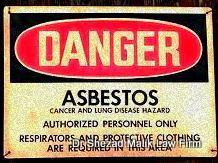Asbestos, Mesothelioma & Lung Cancer

As an Asbestos, Mesothelioma & Lung Cancer attorney, I am going to be providing information on this very important topic. The Dr. Shezad Malik Law Firm helps folks get the recovery they need after being involved in an Asbestos exposure cancer and mesothelioma. Asbestos litigation and mesothelioma lawsuits are called toxic tort litigation.
This type of lawsuit is typically brought against a manufacturer or supplier of a toxic chemical or dangerous substance that causes personal injury, illness or wrongful death.
What is Asbestos?
Asbestos is a fibrous mineral and element that has both unique insulating and fire-retardant properties. These special properties have made asbestos a key component in a wide variety of construction materials and other industrial products.
Asbestos is a group of minerals that occur naturally as fiber bundles. There are 2 main types of asbestos fibers. Chrysotile is the most common asbestos in industrial use, otherwise known as white asbestos, which has curly fibers. Amphibole asbestos fibers are the other type of fibers which are straight and needle-like. Amphibole fibers, come in several types including amosite, crocidolite, tremolite, actinolite, and anthophyllite.
Amphiboles (particularly crocidolite) are more likely to cause cancer, but even the more popular chrysotile fibers have been linked to cancer.
Where is Asbestos Found?
Asbestos was found in many manufactured materials and it was also commonly used in many construction products for industrial and commercial applications, including in manufacturing plants, refineries and shipyards, basically anywhere is uniques fire resistant and insulation properties could be utilized.
Who is at Risk for Developing Asbestos Related Disease?
People are exposed to asbestos fibers in the air they breathe. Asbestos fibers inhalation may occur during mining processing of asbestos containing minerals, making asbestos-containing products, or installing asbestos insulation. Inhalation of asbestos fibers may also occur when aged buildings are razed, renovated, repaired, or when older asbestos-containing materials begin to degrade. People at the highest risk for developing mesothelioma or other asbestos-related illnesses include workers whose employment directly expose them to asbestos fibers, such as miners and ship builders.
The workers with the heaviest exposure and the highest risk are those who worked directly in asbestos industries, such as shipbuilding, refineries, car factories and insulation installation. Many of these people recollect working in thick clouds of asbestos dust daily. Family and friends of these workers are also at risk due to household exposure, from second-hand asbestos. There are cases of spouses and children of workers who develop asbestos-related illnesses like mesothelioma as a result of second-hand exposure to their spouse or parent who was directly or indirectly exposed to asbestos.
Why is Asbestos Harmful?
Asbestos fibers produce dust, and when inhaled, the asbestos dust fibers forms deposits in the lungs that can cause severe diseases including mesothelioma, lung cancer and asbestosis. Many workers exposed to asbestos from the 1940s through the 1970s continue to develop mesothelioma, lung cancer and asbestosis after a very long latency period.
Several federal and state agencies have the authority to regulate asbestos. These agencies include the U.S. Department of Labor/Occupational Safety and Health Administration (OSHA) and the U.S. Environmental Protection Agency (EPA).
Diseases Related to Asbestos Exposure
Several serious diseases are common among workers or family members exposed to asbestos. These are malignant mesothelioma, lung cancer and asbestosis.
Malignant Mesothelioma
Malignant mesothelioma is an extremely aggressive and severe cancer and Asbestos exposure is the only known cause of this terminal illness. There are three types of malignant mesothelioma, Epithelioid, Sarcomatoid and Mixed type.
Lung Cancer
Asbestos exposure is known to cause lung cancer, and the combination of asbestos exposure and cigarette smoking is extremely deadly. The U.S. Surgeon General scientific reports indicate that people who smoke and were exposed to asbestos on the job are 90 times as likely to develop lung cancer as people who smoke but were never exposed to asbestos.
Asbestosis
Asbestosis is a lung disease caused by inhaling asbestos dust. The disease produces inflammation and scarring (fibrosis) of the lung.
Medical Studies and Research
Lung Cancer
Inhalation of asbestos fibers has been linked to an increased risk of lung cancer in many studies of asbestos-exposed workers. Generally, the greater the exposure to asbestos, the higher the risk of lung cancer. Many cases of lung cancer in asbestos workers occur at least 15 years after initial exposure to asbestos. In workers exposed to asbestos who also smoke, the lung cancer risk is many times greater than even adding the risks from these exposures separately. In other words, asbestos exposure and cigarette smoking is a bad combination and can be deadly.
Mesothelioma
Mesothelioma is a rare form of cancer that affects the thin membranes lining organs in the chest (pleura) and abdomen (peritoneum). Mesothelioma is closely linked with asbestos; most cases of mesothelioma result from direct exposure to asbestos at work.
Studies have found an increased risk of mesothelioma among workers who are exposed to asbestos, as well as among their family members and people living in the neighborhoods surrounding asbestos factories and mines.
Mesotheliomas typically takes many years to develop. The duration between asbestos first exposure and the diagnosis of mesothelioma is usually 30 years or more. Sadly, the risk of mesothelioma does not decrease with time after asbestos exposure. The mesothelioma risk appears to be lifelong. And unlike lung cancer, mesothelioma risk is not increased among smokers.
Asbestos and Other Health Problems
The asbestos exposure also causes a major health problem, a lung disease called asbestosis. When a person inhales high levels of asbestos fibers over time, some of the fibers stick deep in the lungs. These asbestos fibers are extremely irritating and inflammatory and eventually lead to scarring (fibrosis) in the lungs. This fibrosis of the lung tissue can make it hard to breathe. The asbestosis main symptoms are shortness of breath and a chronic cough.
When asbestosis occurs, it is typically 10 to 20 years after the initial exposure to asbestos. The disease can get worse over time. While some people may not have serious symptoms, others may be seriously disabled by breathing problems. Unfortunately there is no effective treatment for this disease.
Asbestos fibers can also migrate to the outer lining of the lungs (pleura), where it can lead to pleural plaques (areas of hard, scar-like tissue in the pleura), pleural thickening, and pleural effusions (buildup of fluid between the lungs and the pleura). All of these serious lung diseases can make it harder to breathe and result in a chronic cough.
Were You Harmed by Asbestos Exposure?
Many asbestos disease victims and their families are entitled to receive asbestos exposure compensation because manufacturers of asbestos-containing products often knew about the dangers of asbestos and yet failed to warn or make safe the working conditions.
In fact, asbestos has been linked to cancer as early as the 1930s. The evidence shows that these companies did not advise workers of the potential hazards of their products, nor did they make any effort to put warning labels on the products to inform workers of the dangers of asbestos.
As a result of this failure to warn, hundreds of thousands of workers have developed asbestos-related diseases over the past century. Many have died. Bringing legal action against these companies is one remedy available to you.
How can Dr. Shezad Malik Law Firm Help My Family?
Dr. Shezad Malik as a practicing physician and attorney he understands the devastating consequences of mesothelioma, lung cancer and other asbestos-related diseases.
We have a special understanding of the liability of asbestos defendants. This includes issues as when the manufacturer, supplier, contractor and/or employer first understood about the dangers of asbestos, and what they failed to do to warn and protect workers and their families.
Information and commentary provided by Dallas Fort Worth Personal Injury Attorney Dr. Shezad Malik. The Dr. Shezad Malik Law Firm can be contacted in Dallas at 214-390-3189. If you or a loved one has been injured from Asbestos Mesothelioma or Asbestosis, please fill out our contact card for a free consultation.
Our law firm’s principal office is in Dallas and we have offices in Fort Worth, Texas. Dr. Shezad Malik Law Firm represents clients in dangerous drug and dangerous medical device lawsuits nationwide.


